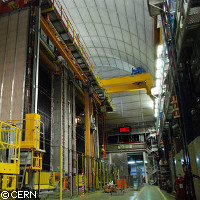Chameleon particle caught in the act
Physicists working at the Istituto Nazionale di Fisica Nucleare (INFN) in Italy have solved a long-standing puzzle in particle physics. After three years of experiments using an intense muon neutrino beam, they have caught an elementary particle changing from one form to another. Their discovery helps explain the apparent disappearance of neutrinos on their journey to and through the Earth. A neutrino, meaning 'small neutral one'; is an elementary particle (like an electron) that has an extremely small mass and can travel close to the speed of light. Neutrinos interact weakly with matter, and pass through the Earth almost undisturbed. There are three types of neutrino - electrons, muons and taus - and they are tricky to detect. Most neutrinos passing through the Earth come from the Sun, but in the 1960s, the American researcher Ray Davis observed that far fewer neutrinos made it to Earth from the Sun than solar models predicted. Since then, physicists have sought to explain why so many seem to get lost along the way. In 1969, Bruno Pontecorvo and Vladimir Gribov, theorists working in Russia, suggested that neutrinos might be oscillating between types, which would explain things. Since then, several experiments have observed the disappearance of muon-neutrinos but have not picked up the spontaneous appearance of tau neutrinos. In 2006, physicists working for CERN (European Organization for Nuclear Research) at Geneva, Switzerland began experimenting with an intense beam of muon neutrinos. Researchers working on the OPERA ('Oscillation project with emulsion-tracking apparatus') experiment at INFN searched for the appearance of tau particles in the beam. Their appearance would mean that muon neutrinos had indeed changed into tau neutrinos. At long last, their patience has been rewarded. The OPERA researchers have for the first time caught a neutrino 'chameleon' in the act of changing from a muon into a tau particle. The result follows seven years of preparation and over three years of experimentation with the CERN beam. During that time, billions upon billions of muon-neutrinos have been sent on the 2.4 millisecond underground journey from CERN to Gran Sasso, 730 kilometres away. 'This success is due to the tenacity and inventiveness of the physicists of the international community, who designed a particle beam especially for this experiment,' explained INFN President Roberto Petronzio. 'In this way, the original design of Gran Sasso has been crowned with success. In fact, when constructed, the laboratories were oriented so that they could receive particle beams from CERN.' 'We are confident that this first event will be followed by others that will fully demonstrate the appearance of neutrino oscillation,' added Antonio Ereditato, OPERA collaboration spokesperson. CERN Director General Rolf Heuer welcomed the result, saying: 'This is an important step for neutrino physics. My congratulations go to the OPERA experiment and the Gran Sasso Laboratories, as well as the accelerator departments at CERN. We're all looking forward to unveiling the new physics this result presages.' The observation of neutrino oscillations paves the way for further important discoveries in astrophysics. Currently, the Standard Model that physicists use to explain the behaviour of fundamental particles holds that neutrinos have no mass. However, the demonstration of neutrino oscillation shows that they must have mass. Revising the Standard Model could help scientists discover new types of neutrinos, shedding light on the theory of dark matter and ultimately the nature of the Universe.
Countries
Switzerland, Italy



